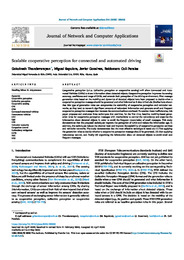Por favor, use este identificador para citar o enlazar este ítem:
https://hdl.handle.net/11000/31368Registro completo de metadatos
| Campo DC | Valor | Lengua/Idioma |
|---|---|---|
| dc.contributor.author | Thandavarayan, Gokulnath | - |
| dc.contributor.author | Sepulcre, Miguel | - |
| dc.contributor.author | Gozalvez, Javier | - |
| dc.contributor.author | Coll-Perales, Baldomero | - |
| dc.contributor.other | Departamentos de la UMH::Ingeniería de Comunicaciones | es_ES |
| dc.date.accessioned | 2024-02-09T11:07:38Z | - |
| dc.date.available | 2024-02-09T11:07:38Z | - |
| dc.date.created | 2023-07 | - |
| dc.identifier.citation | Journal of Network and Computer Applications Volume 216, July 2023, | es_ES |
| dc.identifier.issn | 1095-8592 | - |
| dc.identifier.issn | 1084-8045 | - |
| dc.identifier.uri | https://hdl.handle.net/11000/31368 | - |
| dc.description.abstract | Cooperative perception (a.k.a. Collective perception or cooperative sensing) will allow Connected and Automated Vehicles (CAVs) to share information about detected objects. Cooperative perception improves the sensing accuracy, confidence and range of CAVs, and extends their perception of the driving environment. First message generation rules based on the mobility and dynamics of detected objects have been proposed to decide when a cooperative perception message should be generated and what information it should include. Studies have shown that this type of generation rules can compromise the scalability of cooperative perception and vehicular networks, as they tend to transmit significant amounts of redundant information and generate small and frequent cooperative perception messages that increase the communications overhead. To combat these inefficiencies, this paper proposes and evaluates three techniques that combine, for the first time, baseline mobility-based generation rules for cooperative perception messages with mechanisms to control the redundancy and organize the information about detected objects in order to avoid the frequent transmission of small messages. This study demonstrates that the proposed techniques improve the perception of CAVs and reduce the information age. In addition, the techniques reduce the channel load and improve the scalability of cooperative perception services and vehicular networks. The study demonstrates that the most effective technique is based on: (1) first applying the generation rules to decide whether a cooperative perception message should be generated, (2) then applying redundancy control, and finally (3) organizing the information about all detected objects to avoid small and frequent messages | es_ES |
| dc.format | application/pdf | es_ES |
| dc.format.extent | 14 | es_ES |
| dc.language.iso | eng | es_ES |
| dc.publisher | Elsevier | es_ES |
| dc.rights | info:eu-repo/semantics/openAccess | es_ES |
| dc.rights | Attribution-NonCommercial-NoDerivatives 4.0 Internacional | * |
| dc.rights.uri | http://creativecommons.org/licenses/by-nc-nd/4.0/ | * |
| dc.subject | Cooperative perception | es_ES |
| dc.subject | Collective perception | es_ES |
| dc.subject | Cooperative sensing | es_ES |
| dc.subject | CPS | es_ES |
| dc.subject | CPM | es_ES |
| dc.subject | Connected automated vehicles | es_ES |
| dc.subject | Autonomous vehicles | es_ES |
| dc.subject | CAV | es_ES |
| dc.subject | RSU | es_ES |
| dc.subject | V2X | es_ES |
| dc.subject | Vehicular networks | es_ES |
| dc.subject | Congestion control | es_ES |
| dc.subject | Redundancy mitigation | es_ES |
| dc.subject | C-ITS | es_ES |
| dc.subject | DCC | es_ES |
| dc.subject | ETSI | es_ES |
| dc.subject.other | CDU::6 - Ciencias aplicadas::62 - Ingeniería. Tecnología | es_ES |
| dc.title | Scalable cooperative perception for connected and automated driving | es_ES |
| dc.type | info:eu-repo/semantics/article | es_ES |
| dc.relation.publisherversion | https://doi.org/10.1016/j.jnca.2023.103655 | es_ES |

Ver/Abrir:
Scalable cooperative perception for connected and automated driving (1).pdf
3,46 MB
Adobe PDF
Compartir:
 La licencia se describe como: Atribución-NonComercial-NoDerivada 4.0 Internacional.
La licencia se describe como: Atribución-NonComercial-NoDerivada 4.0 Internacional.
.png)